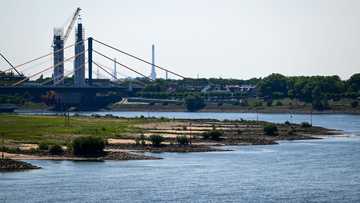What is the largest man-made lake in the world? A list of the top 10 and their size
In the slightly over 2000 years of man’s existence, he has been able to change the world in ways that will leave an everlasting footprint. Most of the scars created by man on this planet stem from mining activities, making the land derelict and hazardous. Sometimes, abandoned quarries can fill up with water to become man-made lakes that support the ecosystem. However, the largest man-made lake in the world is humanity’s legacy because of its many functions.
New feature: Check out news exactly for YOU ➡️ find “Recommended for you” block and enjoy!

Source: Getty Images
Man-made lakes or reservoirs are water bodies used for water resource management. They provide water for domestic use, agricultural irrigation, flood control, recreation, industrial cooling, transport and fisheries. However, such features can also have adverse effects, such as the drying of rivers downstream and the looming danger of disaster should the walls of the lake collapse.
Largest man-made lake in the world
You’d be surprised at the size of the largest man-made lakes in the world. They transformed the landscapes of places where they were established. So what are the top 10 biggest man-made lakes?
1. Lake Kariba – 180 cubic Km

Source: UGC
PAY ATTENTION: Enjoy reading our stories? Join YEN.com.gh's Telegram channel for more!
Lake Kariba is the largest man-made lake in the world, with a water volume of 180 cubic km. It lies on a surface of 5,400 square kilometres in the Kariba Gorge of the Zambezi River. The two countries that share this landmark are Zambia and Zimbabwe.
During the filling of the lake between 1958 and 1963, it is believed that it resulted in more than twenty earthquakes of magnitude greater than five on the Richter scale. The water levels have fallen significantly in recent years due to droughts in the region, but it remains the largest man-made lake in the world.
2. Bratsk Reservoir – 169 cubic Km

Source: UGC
The second-biggest man-made lake in the world is Russia's Bratsk Reservoir. This reservoir has a water volume of 169 cubic kilometres and covers an extensive surface area of 5,470 square kilometres. It was named after its largest adjacent city and stands on the Angara River in Irkutsk Oblast.
The Bratsk Reservoir was constructed in 1967 as a source of hydroelectric power, and it can generate close to 4,500 Megawatts of energy. It also serves as a medium of transportation. It is 125 meters high and has a length of 4,417 meters. At the time of its inauguration, the Bratsk Reservoir was the largest artificial lake in the world.
3. Volta Reservoir – 148 cubic Km

Source: UGC
The third-largest man-made lake in the world is Lake Volta in Ghana. If the size were to be determined by surface area and not water volume, the Volta Reservoir would be the largest artificially created lake in the world. It covers 8,502 square kilometres, which is 3.6 percent of the land area of Ghana.
Lake Volta has a water volume of 148 cubic kilometres. The construction of the Akosombo Dam started in 1961 and was completed in 1965, resulting in the reservoir now known as Lake Volta. The primary sources of the waters of Lake Volta are the White Volta and Black Volta rivers.
4. Manicouagan Reservoir – 139.8 cubic Km

Source: Getty Images
The fourth-largest man-made lake in the world is found in Canada’s central Quebec region. It holds a water volume of 139.8 cubic kilometres and covers a surface area of 1,942 square kilometres. It formed after the construction of the Daniel-Johnson dam between 1959 and 1970, which held back the Manicouagan River and caused the Manicouagan crater to fill.
The lake island at the centre of the lake is Rene-Levasseur Island, which has its highest point at Mount Babel. The structure is believed to have formed 214 million years ago through the impact of a meteorite that was 5 km in diameter.
5. Lake Guri – 135 cubic Km

Source: Getty Images
Lake Guri in Venezuela has a water volume of 135 cubic kilometres and covers a surface area of 4,250 square kilometres. It formed in the Guri Dam found in the Bolivar State on the Caroni River. The dam was opened to the public in 1978.
The dam on which the lake sits is used to generate electricity. It has a power station with 24 turbines that can produce 10,235 MW. It is 7,426 meters long and 162 meters high. The location of the lake is in Necuima Canyon, Bolivar.
6. Lake Nasser – 132 cubic Km

Source: Getty Images
Once again, Africa is on the map of the largest man-made lakes in the world, with Egypt and Sudan's Lake Nasser. It is located in Southern Egypt and Northern Sudan. It has a water volume of 132 cubic kilometres and covers a surface area of 5,250 square kilometres. The primary source of its waters is the Nile River.
The lake resulted from the construction of the Aswan High Dam between 1958 and 1970. It was named after Gamal Abdel Nasser, one of the leaders of the Egyptian Revolution of 1952 and the country's second president. It was officially inaugurated in 1971.
7. Williston Lake – 74 cubic Km

Source: Getty Images
The Williston Lake is a reservoir created by the W.A.C. Bennett Dam found in the Northern Interior of British Columbia, Canada. The lake formed when water filled the basin of the upper Peace River into the Rocky Mountain Trench. The reservoir includes three reaches: the Peace Reach, the Parsnip Reach and Finlay Reach.
Williston Lake has a water volume of 74 cubic kilometres and covers a surface area of 1,761 square kilometres. Muscovite Lakes Provincial Park, Butler Ridge Provincial Park and Heather-Dina Lakes Provincial Park are some of the provincial parks maintained on the shore of the lake.
8. Krasnoyarsk Reservoir – 73 cubic Km

Source: Getty Images
It is an artificial lake in Russia called the Krasnoyarsk Sea. Its water volume is 73.3 cubic kilometres and covers a surface area of 2,000 square kilometres. It was formed after constructing a gravity dam on the Yenisey River near Divnogorsk, Russia. The dam was completed in 1972.
The top point of the lake is located near the town of Abakan. At the lower spot is the Krasnoyarsk hydroelectric power station. Some rivers that feed the reservoir include Sisim, Syda and Tuba.
9. Zeya Reservoir – 68.4 cubic Km

Source: Getty Images
It is a gravity dam built from 1965 to 1975 in Russia. It sits on the Zeya River, where the Zeya Reservoir was constructed. The man-made lake has a surface area of 2,420 square kilometres. Its total capacity has a water volume of 68.4 cubic kilometres.
Zeya Reservoir has a maximum length of 225 kilometres, a depth of 93 meters and a width of 40 kilometres. The Zeya Hydroelectric Power Station has six turbines and generates 4.91 TWh in a year.
10. Robert-Bourassa Reservoir – 61.7 cubic Km

Source: UGC
The lake formed behind the Robert-Bourassa Dam, which was built across the valley of the La Grande River. It is found in Northern Quebec, Canada. The dam was constructed in the mid-1970s as part of the James Bay Project. Its waters feed the Robert-Bourassa and the La Grande-2-A generating stations.
The reservoir has a surface area of 2,835 square kilometres and a volume of 61.7 cubic kilometres. The water is kept inside the reservoir by 31 smaller dikes.
Frequently asked questions
- Is Lake Roosevelt the largest man-made lake in the USA? No, the largest man-made lake in the USA is Lake Oahe.
- What is the largest man-made lake in the US? Lake Oahe is the largest man-made lake in the USA.
- Which is the largest man-made lake in the world? Lake Kariba is the largest man-made lake in the world.
- Which is the largest man-made pond? The Rozmberk Pond has a surface area of 4.89 square kilometres.
- How big is Lake Volta? The man-made lake in Ghana is 8,502 square kilometres in surface area.
- On what continent is Lake Kariba? Lake Kariba is a man-made lake in Africa between Zambia and Zimbabwe.
- Which country has the most lakes? Canada’s 879,800 lakes are the most in a single country.
The largest man-made lake in the world is an embodiment of man's potential to transform vision and dreams into reality. Water is one of the essential resources crucial for the existence of all living things. When trapped in large reservoirs, it can be used to sustain crucial activities such as farming and navigation.
Yen.com.gh shared an article about the largest stadium in the world. Stadiums are architectural marvels that offer enough space to conduct entertainment activities, theatre events, and even celebrations. Nevertheless, the country has seen the rise of mega arenas across different states, with the American football as the largest sport.
Most African countries except South Africa and Nigeria have below-standard coliseums that cannot even feature among the top 1,000. Most of these arenas are owned by independent clubs, giving them the freedom to make any adjustments if needed.
New feature: Check out news exactly for YOU ➡️ find "Recommended for you" block and enjoy!
Source: YEN.com.gh








